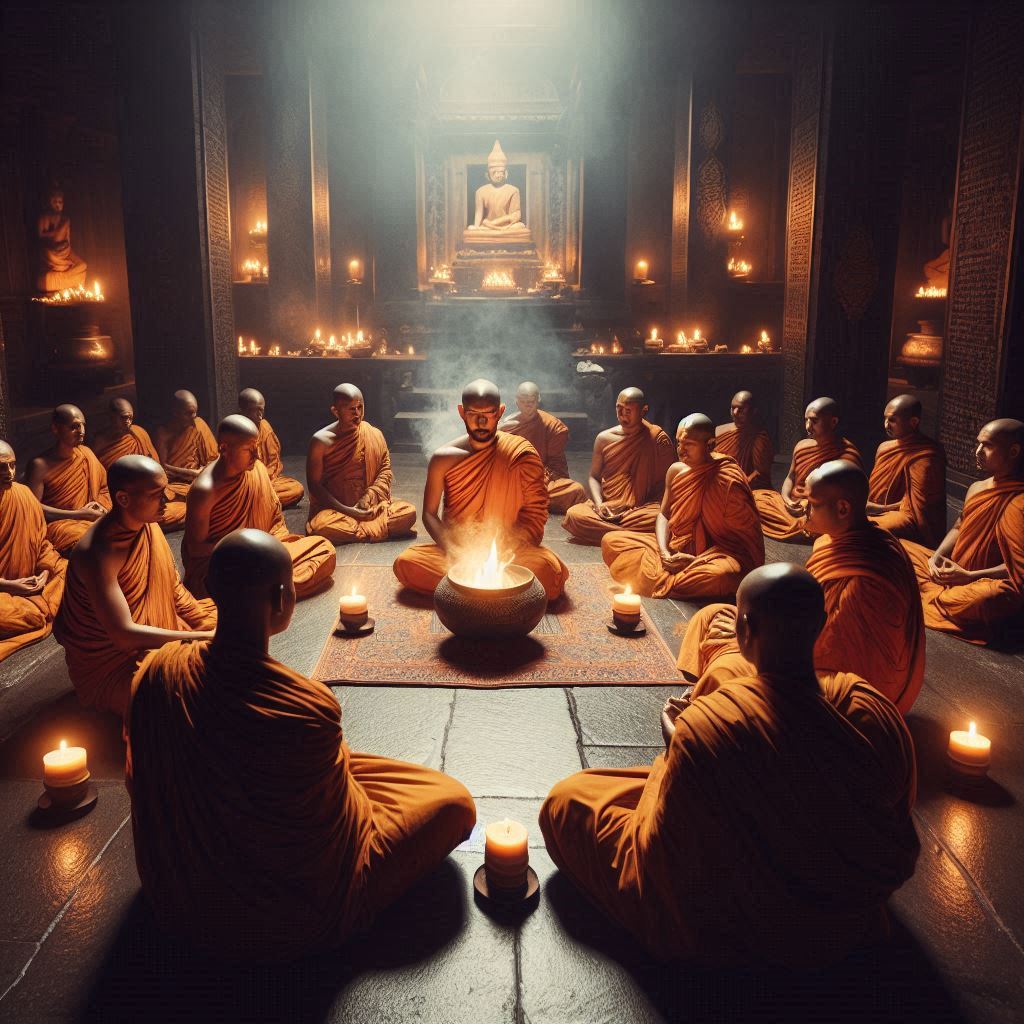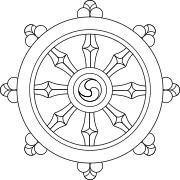The Path to Liberation

Liberation: is there a quick path?
Question: ...The path of liberation you mention is undoubtedly the right path, but... it seems like a long journey. Is there a quicker way to gain insight and escape from the sea of suffering?
Answer: Your understanding of liberation might be somewhat skewed. You should consider the canonical Buddhist teachings: keeping precepts, guarding the sense doors, practicing right mindfulness and right understanding, eliminating the Five Hindrances, attaining the first jhana up to the fourth jhana and finally realizing the ending of defilements. This is the fastest path to liberation, and you can witness it in the present moment.
Perhaps you think that you need to achieve the ending of defilements to be free from suffering and find happiness. But in reality, that's not the case. As soon as you genuinely start keeping precepts, even in the very moment you decide to keep them, you will experience great joy because of that decision. Further, guarding the sense doors will prevent afflictions from invading your mind. Not to mention the inner peace arising from right mindfulness and right understanding, as well as the joy found in meditation.
But why can't you experience joy right away because of keeping precepts? It's because you still lack faith in the Buddha and his teachings. Even though you may think you have faith in the Dharma, you are holding onto a false version of the Dharma. You believe that you can attain some legendary or magical form of Nirvana through a specific method, and this Nirvana will annihilate your afflictions. This is a wrong view, a false interpretation of the Dharma propagated in the world, and those who believe in such a distorted version of the Dharma will not experience joy from keeping precepts. This is because this twisted form of Dharma doesn't require precepts. They think, how could keeping precepts bring joy? People who believe in this distorted version of the Dharma think they will only experience happiness when they've realized something like extinction, Nirvana, awakening, enlightenment, etc., a false Nirvana. Until they drop the illusion of this false Nirvana, they won't experience the unshakable joy of liberation. They might even add more suffering.
However, true Dharma is different. If you understand that so-called Nirvana is the cessation of greed, hatred, and delusion, and not a Nirvana that terminates these, you won't expect to quickly attain something to resolve your afflictions. If you understand that ending afflictions, and preventing them from arising, is the right path to liberation, you'll find joy in keeping precepts because doing so immediately stops unwholesome bodily and verbal actions that lead to the rebirth of coarse afflictions. It's similar to how someone feels elation when they're hungry and then sees food because they know eating is the only way to end their hunger. When someone who's nearly starving sees food, they're filled with ecstatic joy. They don't have to wait until they're full to feel happy.
In the same way, if you know what the right Dharma is, and believe in it, you'll feel joy when you make the decision to keep precepts. The moment you decide to keep precepts, guard the sense doors, practice right mindfulness and right understanding, you will be brimming with joy. Deep inside, you will have no doubt that you now have hope and are on your way to eliminating afflictions. Thus, you should seek the right view in the suttas to understand what Buddha Dharma is, and what liberation is and what the path to liberation is. That's what you need to do right now.
Addendum:
People have accepted teachings that suggest that through certain practices, they can attain a sudden realization of something like extinction, Nirvana, awakening, enlightenment, etc., quickly eradicating greed, hatred, and delusion, putting an end to afflictions, eliminating suffering, and achieving transcendental sanctity. From ancient times to the present, many people have propagated such teachings. However, these are not the teachings of the Tathāgata, nor are they the true path to liberation. If you strip away all interpretations and simply study the suttas, you will find that the entire canon teaches from various perspectives how to eliminate greed, hatred, and delusion concerning form, feeling, perception, volitional formations, and consciousness. This is because the elimination of greed, hatred, and delusion is Nirvana, just as eliminating illness is health. It is not some sort of thing called health that eliminates illness. Keeping precepts can eliminate the most evil forms of greed, hatred, and delusion. Guarding the sense doors can stop new greed, hatred, and delusion from arising. Right mindfulness and right understanding can remove more subtle forms of greed, hatred, and delusion.
By eliminating the Five Hindrances, the mind becomes righted. Through rightening the mind, true reality is seen. With this vision of true reality, defilements are completely eliminated, and defilement cessation is the ending of afflictions; affliction cessation is the ending of suffering; and suffering cessation is the ending of all suffering.

The Tathagata's Teachings
After obtaining enlightenment, the Tathagata (Buddha) initially hesitated to teach because the profound nature of his insights were too deep and subtle to grasp. He believed that complex concepts like not-self and dependent origination could not be understood by ordinary beings, who were preoccupied with worldly pleasures and attachments.
The Tathagata’s reluctance to teach was overcome when Brahma Sahampati, a high deity, urged him to share his teachings, assuring him that there were individuals with little dust in their eyes, ready to comprehend and benefit from his teachings.
Consequently, the Tathagata began teaching, delivering his first sermon at the Deer Park in Sarnath, which marked the start of his extensive teaching career spanning 45 years.
So, it's important to remember that although his teachings have been adapted for the general public and Buddhism has become a religion, the Tathagata's teachings were never meant for the general public. They were meant only for those few people with "little dust in their eyes" who were willing to renounce, seek the truth and make the considerable effort needed to achieve liberation from "the world."
SN56.31: The Blessed One, while in the Sīsapā forest near Kosambi, used sīsapā leaves to illustrate a point to the disciples. He compared the few leaves in his hand to the vast number in the forest, explaining that what he has taught them is only a small fraction of what he knows. However, he chose to teach only what leads to enlightenment and Nibbāna, focusing on the nature of suffering, its origin, cessation, and the path leading to its cessation. This teaching is essential for achieving the holy life and ultimate peace.
Penetrating the Suttas
To penetrate the Tathagata's teachings, one will need to read, recall, and frequently contemplate his teachings and put them into practice to clearly realize their meaning for oneself.
However, one must keep in mind that the Tathagata's teachings were intended for people with a very different mindset who lived 2,600 years ago. We now live in a world where people are overwhelmed with information, have very short attention spans, where words have lost their value, and very few people are willing to figure things out for themselves.
This means that you will have to change your expectations about how teachings should be delivered, not as step-by-step instructions to follow but as pointers in the direction to explore and discover the truth that lies inside for yourself.
It's also extremely important to understand that the Tathāgata teaches only about suffering and the cessation of suffering. His teachings are not about physical reality, how things "should be," or some ultimate "true reality" in a philosophical sense. Instead, they are entirely focused on mental experience and how we can train the mind to let go of suffering.
Only by practicing will you be able to understand the Tathagata's teachings. It is not enough to understand his teachings at the conceptual level.
Read the following Sutta to understand the Tathagata's gradual training path and how each part of the path is dependent on mastery of previous stages.
Read another Sutta that covers the whole of the path from a different angle:
How to Read Suttas
It's important to remember that the Tathagata adapted his teachings to various audiences with different mindsets and diverse situations.
What we have now in the form of Suttas was written down many centuries after the Tathagata's passing away. Before then, the Suttas were formatted in such a way, with a lot of repetition, so that they could easily be memorized for chanting, which is how they were passed on for hundreds of years before they were written down. The format was not meant for modern-style reading, but to be chanted and remembered easily.
It's important to understand that the mindset back then differs greatly from today, so we should be cautious not to consider English translations as the exact words of the Tathagata. Many words in the Pali language don't have English equivalents, and some concepts and ways of thinking are radically different and are no longer present in the modern world.
The Tathagata's teachings are primarily about freeing the mind from its deluded perceptions of the world; it's important not to confuse his teachings as being about the physical world itself.
Further points to keep in mind about the Suttas:
-
As a result of his 45 years of discourses, 84,000 suttas were recorded. Each of the suttas was delivered as a doorway to liberation, tailored to the different needs of people and audiences that he encountered. However, this doesn't mean you should read all 84,000 suttas or that you will understand any of them. Read suttas pertinent to your practice at the time by trying to understand the overall meaning, then practice finding the truth for yourself. Then, read them again to validate your practice.
-
It's important not to cling to or attempt to understand the exact meaning of words, as words cannot truly convey the deep concepts of Dharma. Instead, try to understand the big picture being created, view Suttas as a guide, and discover their meaning through practice.
-
Many words in the Pali language, when translated into English, have a static meaning. For instance, "right" could be interpreted as right or wrong, but the correct interpretation is as actions, movements, cause, and effect. Therefore, "Right Speech" should be seen as a constant process, for example, aiming to avoid causing harm to others through speech.
-
Words like suffering and evil have extreme connotations in the modern world; however, in ancient times, suffering had a much broader meaning and could also mean mild discomfort. Evil can also be interpreted as unnatural.
-
The Suttas are full of similes. In the same way that a picture is worth a thousand words, the Tathagata uses similes and stories to convey meaning in a way that is more accurate than words alone can achieve. So don't dismiss them as not relevant to modern times or just simple stories; they are powerful instructions on how to practice and develop the right states of mind. They aid in visualizing the mindset required to practice correctly.
-
Most Suttas target people at different levels of attainment, such as laypersons, stream-enterers, once-returners, non-returners, and arahants. If you find a sutta challenging to understand, it may be aimed at a more advanced level, and the conditions might not be present yet for you to comprehend it. In such cases, explore another Sutta for contemplation.
-
Many Suttas paint a picture of practice at the conventional level; however, often the message is also meant to be used at the very subtle level of practice. For example, clinging and aversion will also manifest as very subtle movements of the mind.
-
Sutta translations are far from perfect and may contain errors. There's no need to cling to exact wording; try to understand the overall message, which becomes evident as you read more Suttas.
Keep in mind that the reason the Tathagata never gave precise instructions or didn't go into great detail regarding his teachings is because the only way to get insight is to develop it for yourself. Just listening to or reading Dhamma will not do. He only pointed the way and roughly how to get there. The rest has to be figured out by oneself through contemplation and practice.
View the Suttas as guides that need verification through practical experience rather than rigid adherence.
Contemplation

Questions for contemplation:
-
Going through the Tathagata's Gradual Training, reflect on how each part of the process deals with different levels of clinging, aversion, and delusion.
-
Why is the practice of jhana an advanced part of the Gradual Training?
-
Can you see how people who start with jhana first are bound to fail?

Now read the second part of the Sutta and contemplate the Tathagata's explanation as to why some of his students never reach their destination.
Read the third part of the Sutta and consider if you have the qualities to start on this path.
It is good practice to memorize key parts of the Suttas, contemplate them, and recall them as relevant circumstances arise, this is the contemplative path.
Verily, one ought to tread with utmost circumspection whilst delving into the sacred scriptures, for it behooves the reader to bear in remembrance the formidable challenge of comprehending writings penned three centuries hence.
Not to mention the considerable difficulty in grappling with a distinct tongue and the distant bygone age that stretches two and a half millennia into the past.

Finally, consider that the Tathagata's teachings, wrongly grasped, lead not to liberation but deeper suffering:

Just as a man seeking a water snake, searching for a water snake, wandering in search of a water snake, might see a large water snake.
He would catch it by the body or the tail. That water snake would turn back and bite him on the hand, arm, or some other part of the body. Because of that, he would meet death or deadly suffering. What is the reason for this? Because of the wrong grasp of the water snake, disciples.
In the same way here some foolish people learn the teachings: the discourses, mixed prose and verse, explanations, verses, inspired utterances, sayings, birth stories, extraordinary teachings, and analyses. Having learned the teachings, they do not examine the meaning of those teachings with wisdom. For them, those teachings, not examined with wisdom, do not lead to deep understanding.
They learn the teachings for the sake of fault-finding and for the sake of winning debates. They do not experience the purpose for which they learn the teachings. For them, those teachings, wrongly grasped, lead to long-term harm and suffering.
MN22